Page 216 of 558
WARNING!
In a collision, a cargo cover loose in the vehicle could
cause injury. It could fly around in a sudden stop and
strike someone in the vehicle. Do not store the cargo
cover on the cargo floor or in the passenger compart-
ment. Remove the cover from the vehicle when taken
from its mounting. Do not store in the vehicle.
REAR WINDOW FEATURES
Rear Window Wiper/Washer
The rear wiper/washer is controlled by a rotary switch
located on the control lever. The control lever is located
on the right side of the steering column.Rotate the switch upward to the first detent posi-
tion for rear wiper operation.
NOTE: The rear wiper operates in an intermittent mode
only.Rear Wiper/Washer Control
214 UNDERSTANDING THE FEATURES OF YOUR VEHICLE
Page 223 of 558
�Media Center 130 With Satellite Radio
(Sales Code RES+RSC) ................... 282
▫ Operating Instructions — Radio Mode ..... 283
▫ Operation Instructions — CD Mode For CD
And MP3 Audio Play ................. 289
▫ Notes On Playing MP3 Files ............ 291
▫ List Button (CD Mode For MP3 Play) ...... 293
▫ Info Button (CD Mode For MP3 Play) ...... 293
▫ Uconnect™ Multimedia (Satellite Radio) — If
Equipped .......................... 294 �
Steering Wheel Audio Controls ............ 298
▫ Radio Operation ..................... 299
▫ CD Player ......................... 300
� CD/DVD Disc Maintenance .............. 300
� Radio Operation And Mobile Phones ....... 301
� Climate Controls ...................... 301
▫ Manual Heating And Air Conditioning ..... 301
▫ Automatic Temperature Control (ATC) — If
Equipped .......................... 305
▫ Operating Tips ...................... 311
4
UNDERSTANDING YOUR INSTRUMENT PANEL 221
Page 229 of 558
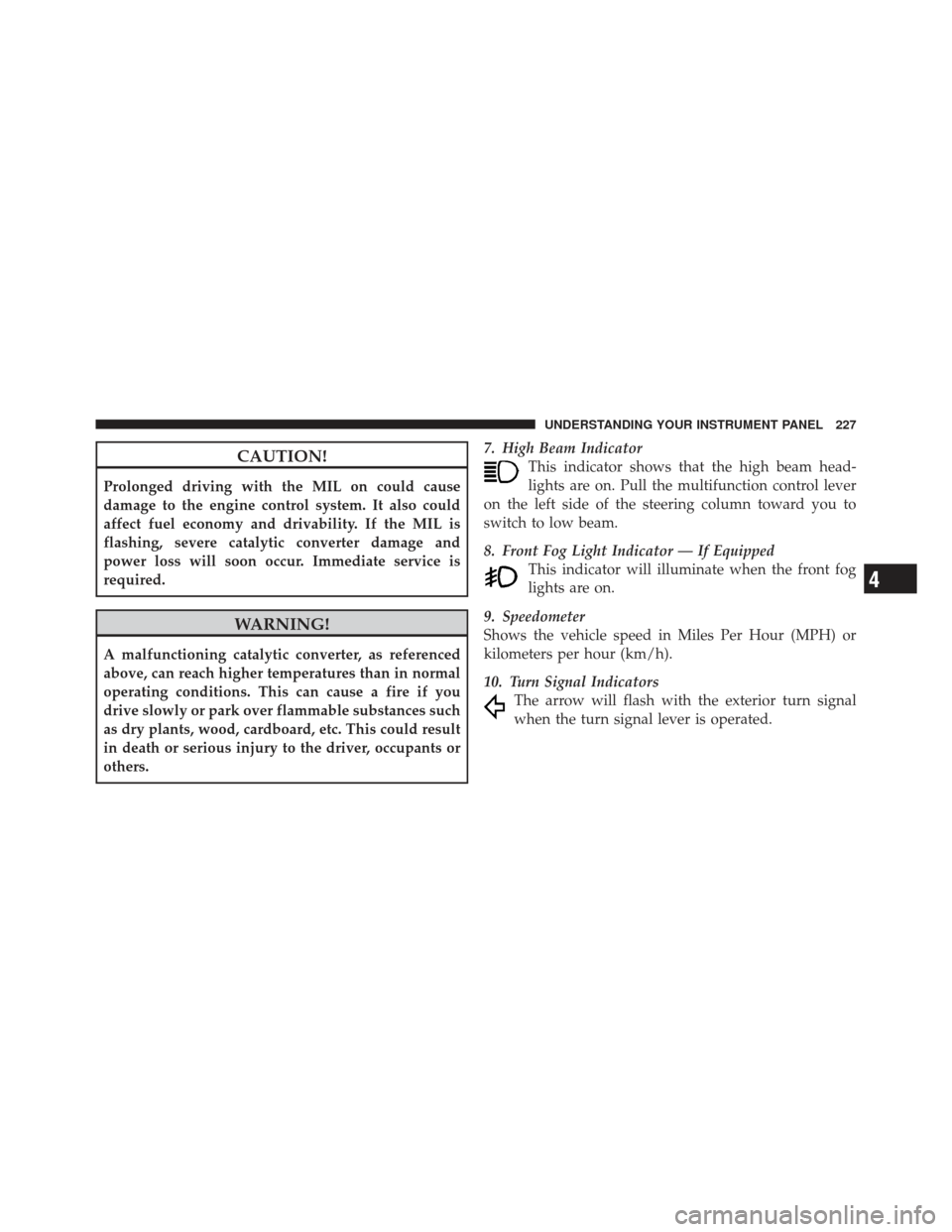
CAUTION!
Prolonged driving with the MIL on could cause
damage to the engine control system. It also could
affect fuel economy and drivability. If the MIL is
flashing, severe catalytic converter damage and
power loss will soon occur. Immediate service is
required.
WARNING!
A malfunctioning catalytic converter, as referenced
above, can reach higher temperatures than in normal
operating conditions. This can cause a fire if you
drive slowly or park over flammable substances such
as dry plants, wood, cardboard, etc. This could result
in death or serious injury to the driver, occupants or
others.7. High Beam Indicator
This indicator shows that the high beam head-
lights are on. Pull the multifunction control lever
on the left side of the steering column toward you to
switch to low beam.
8. Front Fog Light Indicator — If Equipped This indicator will illuminate when the front fog
lights are on.
9. Speedometer
Shows the vehicle speed in Miles Per Hour (MPH) or
kilometers per hour (km/h).
10. Turn Signal Indicators The arrow will flash with the exterior turn signal
when the turn signal lever is operated.
4
UNDERSTANDING YOUR INSTRUMENT PANEL 227
Page 242 of 558
This system conveniently allows the driver to select a
variety of useful information by pressing the switches
mounted on the steering wheel. The EVIC consists of the
following:
•Compass Heading (N, S, E, W, NE, NW, SE, SW)
•Outside Temperature (°F or °C)
•Audio Information/ECO Display
•Fuel Economy
•Miles/kilometers To Empty
•Tire Pressure Status — if equipped
•Timer
•Display Units Selection
•System Warnings (Door Ajar, etc.)
•Personal Settings (Customer-Programmable Features)The system allows the driver to select information by
pressing the following buttons mounted on the steering
wheel:
EVIC Steering Wheel Buttons
240 UNDERSTANDING YOUR INSTRUMENT PANEL
Page 300 of 558
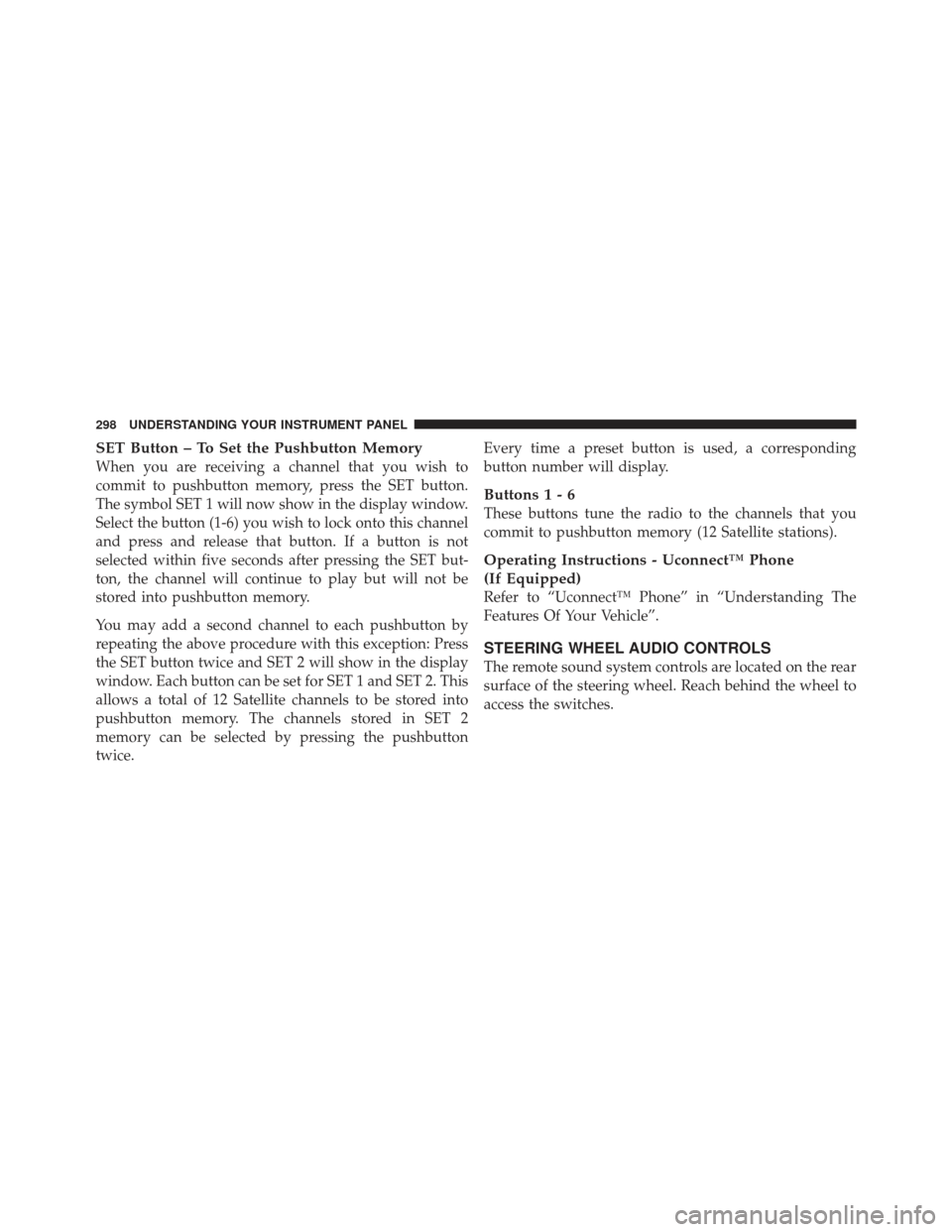
SET Button – To Set the Pushbutton Memory
When you are receiving a channel that you wish to
commit to pushbutton memory, press the SET button.
The symbol SET 1 will now show in the display window.
Select the button (1-6) you wish to lock onto this channel
and press and release that button. If a button is not
selected within five seconds after pressing the SET but-
ton, the channel will continue to play but will not be
stored into pushbutton memory.
You may add a second channel to each pushbutton by
repeating the above procedure with this exception: Press
the SET button twice and SET 2 will show in the display
window. Each button can be set for SET 1 and SET 2. This
allows a total of 12 Satellite channels to be stored into
pushbutton memory. The channels stored in SET 2
memory can be selected by pressing the pushbutton
twice.Every time a preset button is used, a corresponding
button number will display.
Buttons1-6
These buttons tune the radio to the channels that you
commit to pushbutton memory (12 Satellite stations).
Operating Instructions - Uconnect™ Phone
(If Equipped)
Refer to “Uconnect™ Phone” in “Understanding The
Features Of Your Vehicle”.
STEERING WHEEL AUDIO CONTROLS
The remote sound system controls are located on the rear
surface of the steering wheel. Reach behind the wheel to
access the switches.
298 UNDERSTANDING YOUR INSTRUMENT PANEL
Page 301 of 558
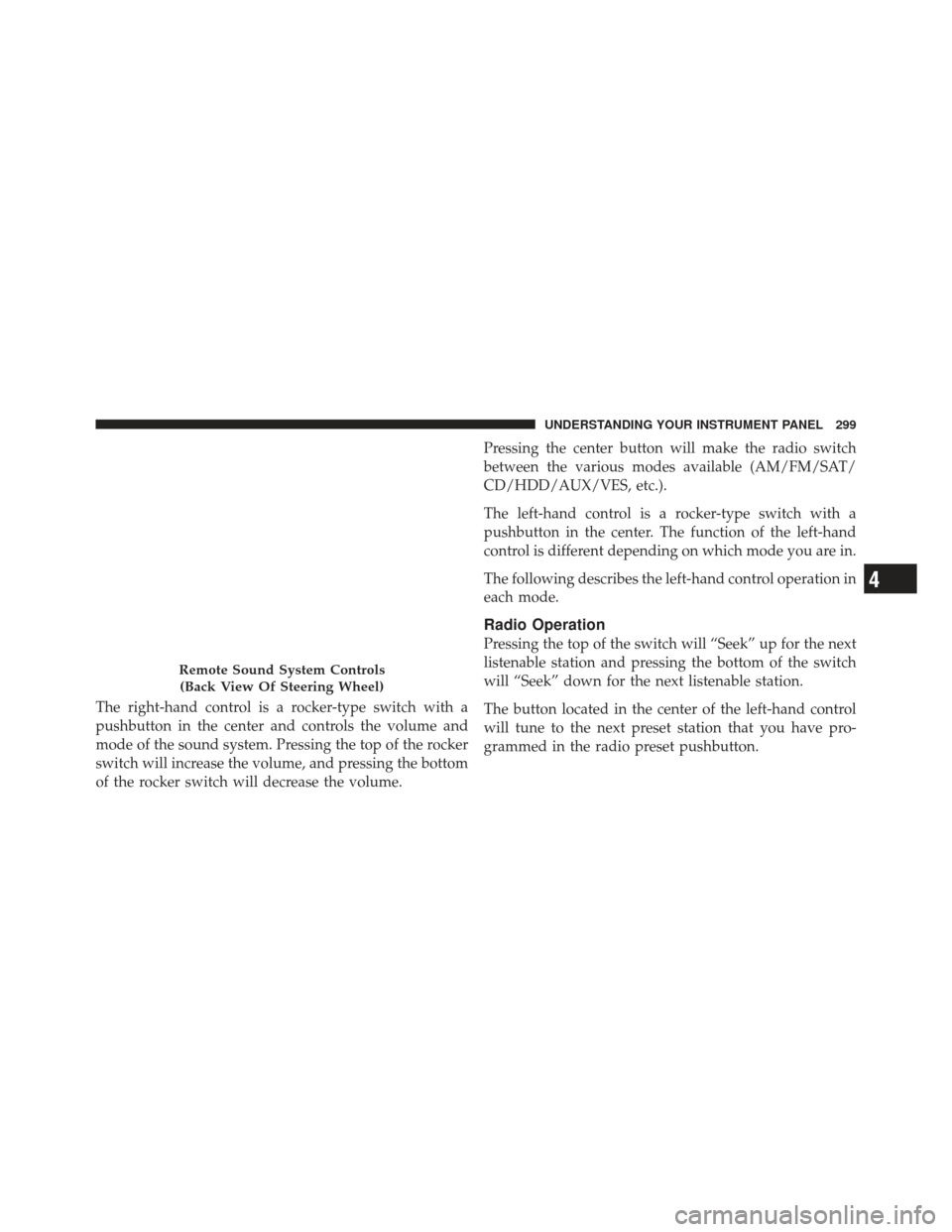
The right-hand control is a rocker-type switch with a
pushbutton in the center and controls the volume and
mode of the sound system. Pressing the top of the rocker
switch will increase the volume, and pressing the bottom
of the rocker switch will decrease the volume.Pressing the center button will make the radio switch
between the various modes available (AM/FM/SAT/
CD/HDD/AUX/VES, etc.).
The left-hand control is a rocker-type switch with a
pushbutton in the center. The function of the left-hand
control is different depending on which mode you are in.
The following describes the left-hand control operation in
each mode.
Radio Operation
Pressing the top of the switch will “Seek” up for the next
listenable station and pressing the bottom of the switch
will “Seek” down for the next listenable station.
The button located in the center of the left-hand control
will tune to the next preset station that you have pro-
grammed in the radio preset pushbutton.
Remote Sound System Controls
(Back View Of Steering Wheel)
4
UNDERSTANDING YOUR INSTRUMENT PANEL 299
Page 318 of 558
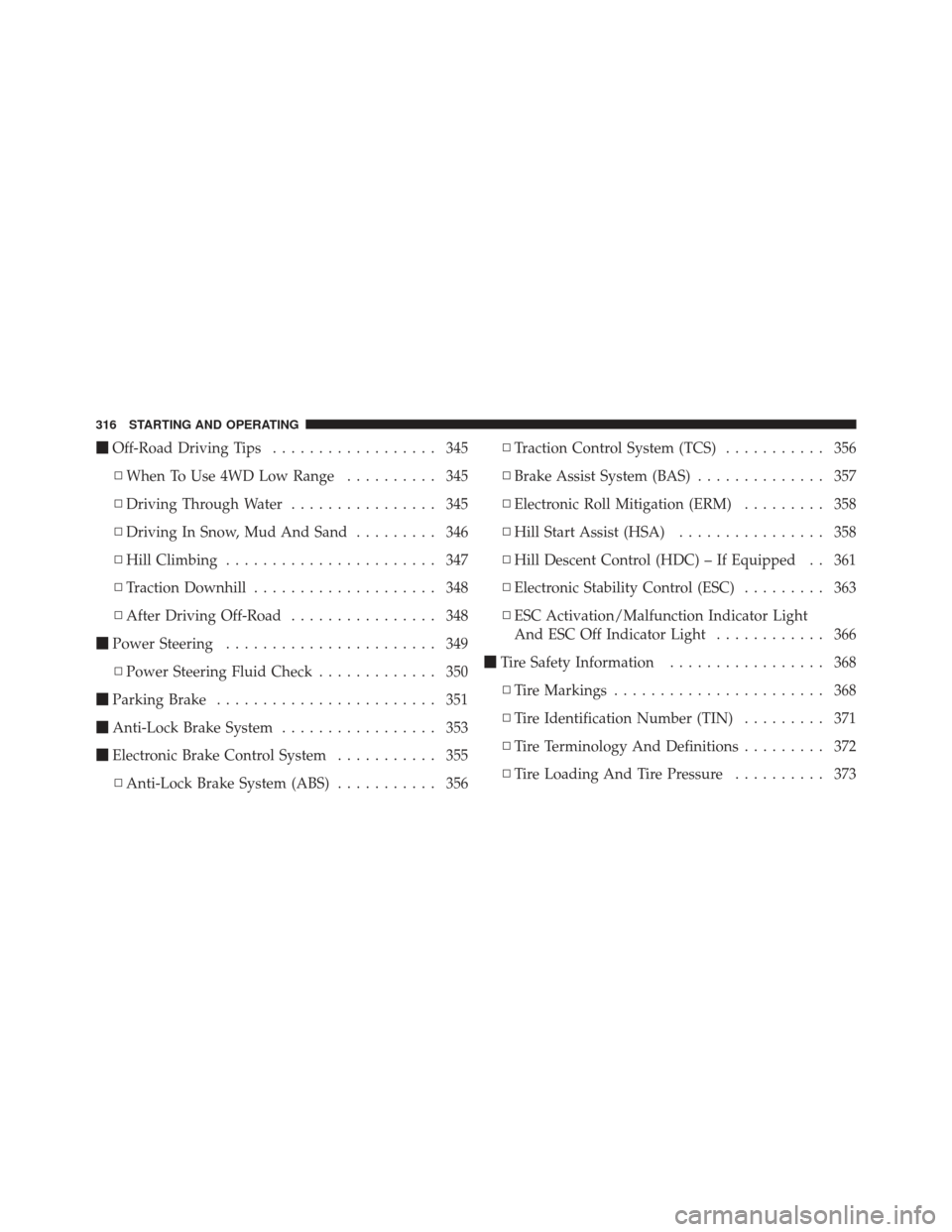
�Off-Road Driving Tips .................. 345
▫ When To Use 4WD Low Range .......... 345
▫ Driving Through Water ................ 345
▫ Driving In Snow, Mud And Sand ......... 346
▫ Hill Climbing ....................... 347
▫ Traction Downhill .................... 348
▫ After Driving Off-Road ................ 348
� Power Steering ....................... 349
▫ Power Steering Fluid Check ............. 350
� Parking Brake ........................ 351
� Anti-Lock Brake System ................. 353
� Electronic Brake Control System ........... 355
▫ Anti-Lock Brake System (ABS) ........... 356▫
Traction Control System (TCS) ........... 356
▫ Brake Assist System (BAS) .............. 357
▫ Electronic Roll Mitigation (ERM) ......... 358
▫ Hill Start Assist (HSA) ................ 358
▫ Hill Descent Control (HDC) – If Equipped . . 361
▫ Electronic Stability Control (ESC) ......... 363
▫ ESC Activation/Malfunction Indicator Light
And ESC Off Indicator Light ............ 366
� Tire Safety Information ................. 368
▫ Tire Markings ....................... 368
▫ Tire Identification Number (TIN) ......... 371
▫ Tire Terminology And Definitions ......... 372
▫ Tire Loading And Tire Pressure .......... 373
316 STARTING AND OPERATING
Page 350 of 558
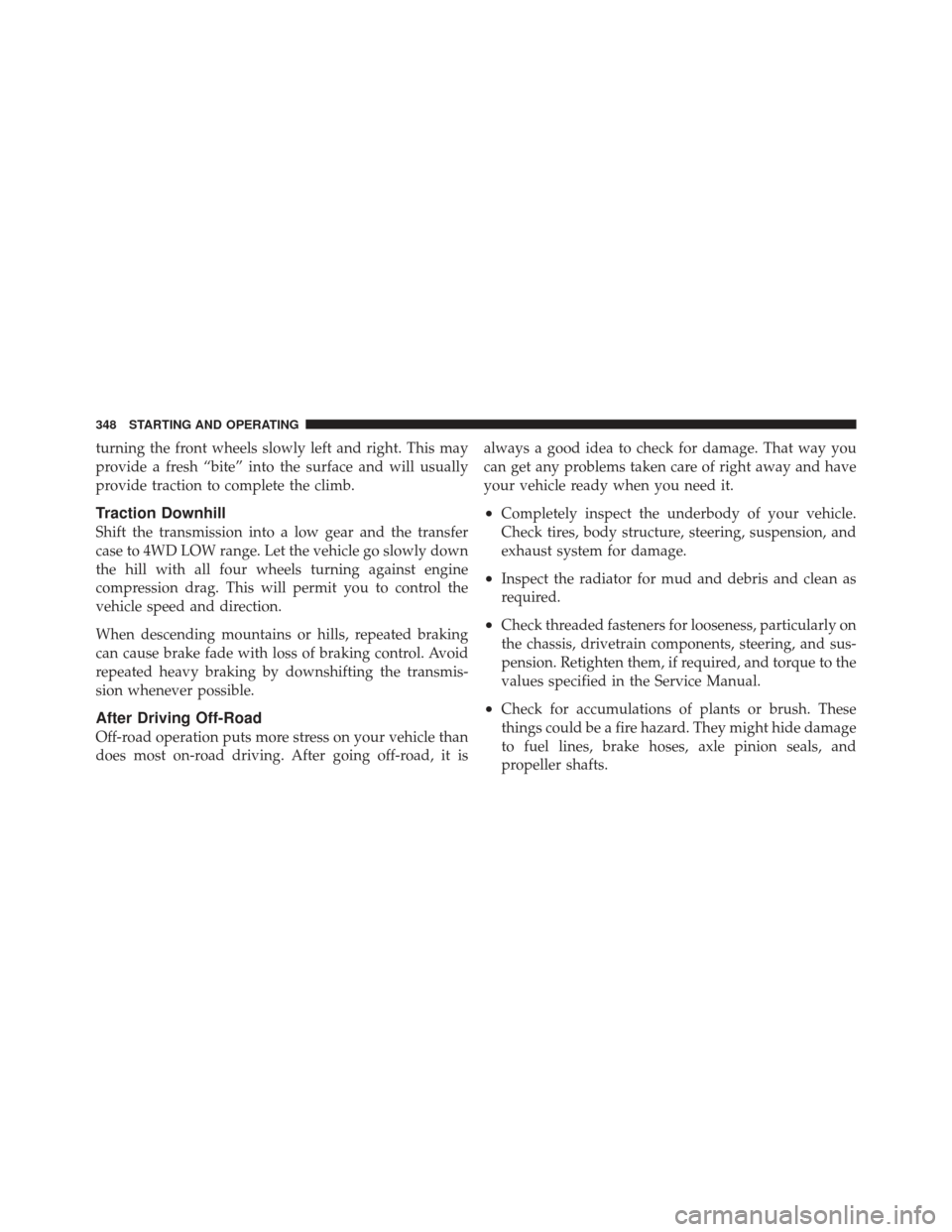
turning the front wheels slowly left and right. This may
provide a fresh “bite” into the surface and will usually
provide traction to complete the climb.
Traction Downhill
Shift the transmission into a low gear and the transfer
case to 4WD LOW range. Let the vehicle go slowly down
the hill with all four wheels turning against engine
compression drag. This will permit you to control the
vehicle speed and direction.
When descending mountains or hills, repeated braking
can cause brake fade with loss of braking control. Avoid
repeated heavy braking by downshifting the transmis-
sion whenever possible.
After Driving Off-Road
Off-road operation puts more stress on your vehicle than
does most on-road driving. After going off-road, it isalways a good idea to check for damage. That way you
can get any problems taken care of right away and have
your vehicle ready when you need it.
•Completely inspect the underbody of your vehicle.
Check tires, body structure, steering, suspension, and
exhaust system for damage.
•Inspect the radiator for mud and debris and clean as
required.
•Check threaded fasteners for looseness, particularly on
the chassis, drivetrain components, steering, and sus-
pension. Retighten them, if required, and torque to the
values specified in the Service Manual.
•Check for accumulations of plants or brush. These
things could be a fire hazard. They might hide damage
to fuel lines, brake hoses, axle pinion seals, and
propeller shafts.
348 STARTING AND OPERATING